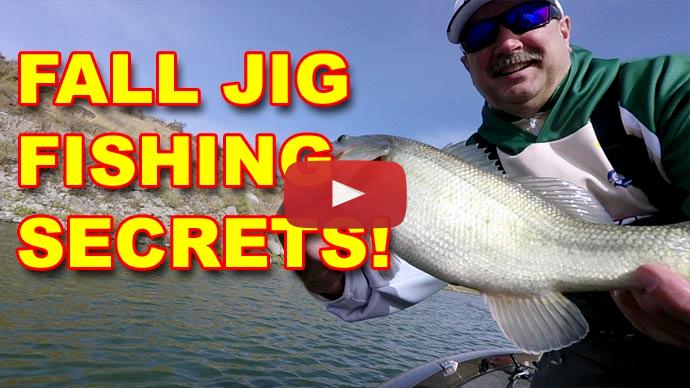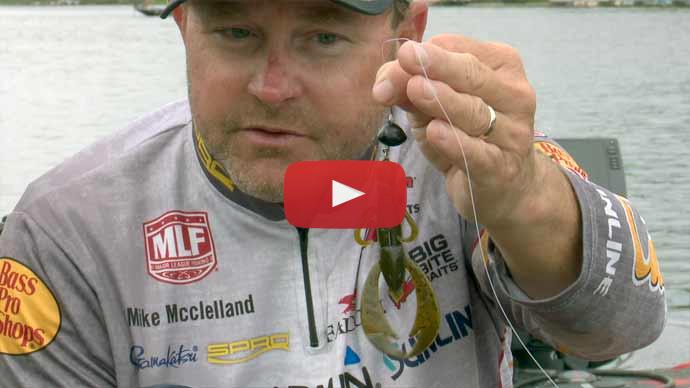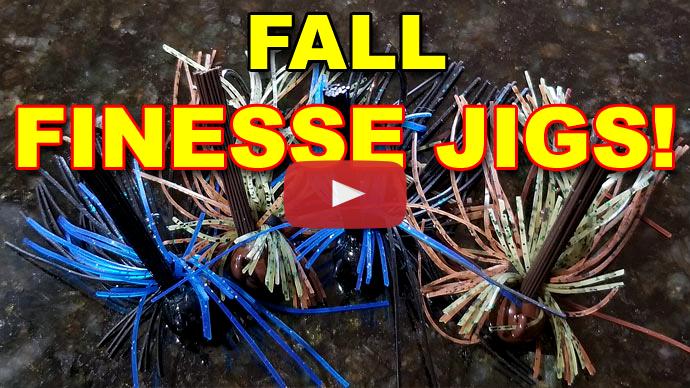Hey, everyone, Mike McClelland here with BassResource to talk about fall jig fishing. And, you know, it's just that time of year when fishing can kind of get tough. It doesn't really matter what part of the country you're in, when you start talking about fall fishing, fishing gets tough. And one of the biggest reasons you gotta understand that fishing does typically get tough in the fall is that transitional period when the thermocline breaks up in a body of water. Now, that's gonna be a period of about a two or three-week period where fish just really freak out and it really, really gets tough. But leading up to that thermocline breaking up, and then once it breaks up, you really can catch a lot of fish on a jig.
And, you know, typically, in the fall, anywhere you go across the country, a lot of different things are happening. You know, sometimes the water temperature's cooling down, the fish are getting a little bit active. They're starting to, you know, chase shad on the surface and things like that. They're, you know, up chasing shore minnows and a lot of different things like that. So, I'm always gonna have a swim jig in my arsenal in the fall.
You know, shad colors typically are gonna be something that plays when I'm fishing, you know, lakes that got colored water, got a lot of, you know, baitfish in them, especially when you get up into the backs of the creeks into, you know, some of the river systems, things like that. A shad-colored swim jig in the fall can really be a key, you know, 1/4 ounce, 3/8 ounce, 5/16, 1/2 ounce swim jig with, you know, generally shad style trailers. I mean, I typically like a Big Bite Swimon. I like a Big Bite Pro Swimmer, Big Bite Finesse Swimmer, something to make that bait, you know, really look like a shad.
Typically, you know, there's gonna be those situations where there's still some bream spawning, you know, late summer into the early part of the fall. So, bream-colored swim jig can also play in the fall. But generally, the thermocline, in my opinion, in the fall is probably the biggest key to catching fish on a jig if you're fishing a lake that develops a thermocline.
And, you know, using your electronics today, I mean, we've all got good electronics today, you can get out. And typically the best way to find the thermocline is get out over, you know, some of the deepest water in the lake and adjust your sensitivity up till the screen starts to kind of blackout and then back it back down. And you'll start seeing a real defined haze at a certain level on your electronics. Or you'll just start noticing that all of the shad, all of the bait fish, all of the fish that you're seeing, all typically are at one specific depth. And once you determine where that thermocline is, that's really where I'm gonna start my focus with fall jig fishing offshore.
And, you know, I'm basically gonna do that with always a football jig. I mean, I'm generally gonna be throwing a 5/8 ounce, 3/4 quarter ounce football jig in a variety of, you know, different colors. Crawfish colors typically are gonna be my first choice. I like a lot of green pumpkins with different shades of, you know, oranges, browns, greens, things of that nature, you know, depending on what the main forage is in a body of water.
Trailers can be a big, big deal that time of the year. And I think you gotta really go through a lot of different trailers until you determine, you know, what the fish wants. Sometimes they want a trailer that's relatively subtle when you get to the fall. A lot of times, I'll use a bait with a little Big Bite Sensation Quarantine Craw, just something real finesse. Those fish have gotten a lot of pressure a lot of times, and something like this little Big Bite Quarantine Craw, it's scented, it's gonna give you the maximum opportunity to generate bites. I'm throwing it on a little 3/8 ounce, 1/2 ounce, little hybrid head that I'm working on designing right now for a Big Bite. And it's a bait that I can generate a lot of bites on if I'll focus my efforts out there around the thermocline.
Sometimes a big, you know, floppy style trailer will get bites and, you know, something like the Big Bite Kamikaze Craw is a good trailer, a Big Bite Battle Bug.
But one of the things in the fall that becomes critical is once you determine where that thermocline is, a lot of times a lot of the fish you catch, you're gonna catch them on the move. We do a lot of what we call strolling. Get out there at that thermocline depth, and you're basically just dragging your jig around, football jig around at that specific depth. And that's where the size of your jig becomes so critical.
I mean, if you're fishing a lake that the thermocline sits up in, you know, say 12-foot, 15-foot, 18-foot of water, you know, you can get away with generally a 1/2 ounce or a 5/8 ounce. But if you're fishing one of those deep clear Ozark lakes like we have there in the Ozarks, a lot of times those fish will get, you know, 30-foot, 35-foot, 40-foot, 45-foot and that's when you've got to have, you know, a 3/4 ounce, even sometimes a 1-ounce football jig to keep that bait down there on the bottom because it seems like your success rate really goes up when you're dragging that jig at a constant speed. On those days when the wind blows, it's really, really weird because it feels like if you will fish that jig at the rate that the natural flow of the water moving is, that's when you tend to generate the most bites.
When it comes to rods and reels, I mean, my jig fishing doesn't vary a lot through the course of the year. I mean, 99% of the time I'm gonna be throwing two different rods when I'm throwing a jig. I'm either gonna be throwing a Falcon 6174. Generally, in the fall or in...yeah, in the fall,
I'm still gonna be throwing Sunline Shooter. It is the flourocarbon that has the absolute least amount of stretch. It is the most sensitive, it's the one that to me, gets the job done in those warmer months of the year. It isn't as soft and pliable as a shoot or a Sniper. But during the summer, the warmer months of the year, and the fall, you can definitely use the Shooter and have maximum success.
Line size. Typically, in the fall, I want my rate-of-fall to be a little bit faster sometimes, because a lot of times when you've determined the depth those fish are at that thermocline, it becomes critical, you know, they'll bite that bait on that initial presentation. So, you know, a lot of times I'll back down to 16 Shooter in the fall because I want that high rate-of-fall, especially when I'm throwing, you know, 3/4 once, 1-ounce football jig.
Another thing that you really wanna keep in mind when you're looking for fish in the fall is determining where those fish are relating to that thermocline. There's two or three things that I really look at. I'll look at where a creek channel makes a swing onto a flat. And what I wanna do is I wanna find where that thermocline and that flat meet each other.
A lot of times, you know, just long gravel flats out on the main lake can be another real key. And I'll just graph and idle around till you find, you know, brush piles, old stumps, you know, little ledges that basically come and coincidence with where the thermocline hits the bottom of the lake.
And then the other place that I really, really like to look for fall jig fish is on bluff endpoints. Anywhere you've got like a major bluff end that swings out and makes a point, they really like to set up on those bluff endpoints in the fall.
Timber is just an added bonus. I love to fish standing pole timber, you know, some isolated cedar trees. You don't wanna be out there just dragging around on bare flats. You wanna look for the structure and, you know, that's when our electronics become so important anymore. You know, with Livescope now, you're not out there just dragging a jig around. You're out there throwing a jig at fish that you can actually see whether they're set up on brush, whether just set up at the thermocline level or an isolated stump or a ledge. You gotta pay attention to your electronics. So, use those tips and I think you're gonna catch more fish on a jig this fall.



